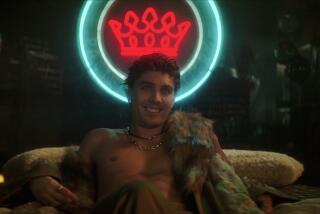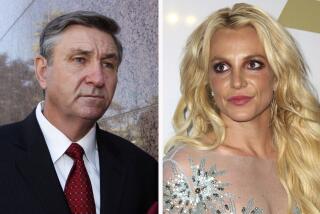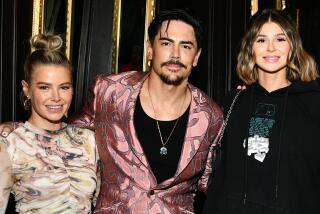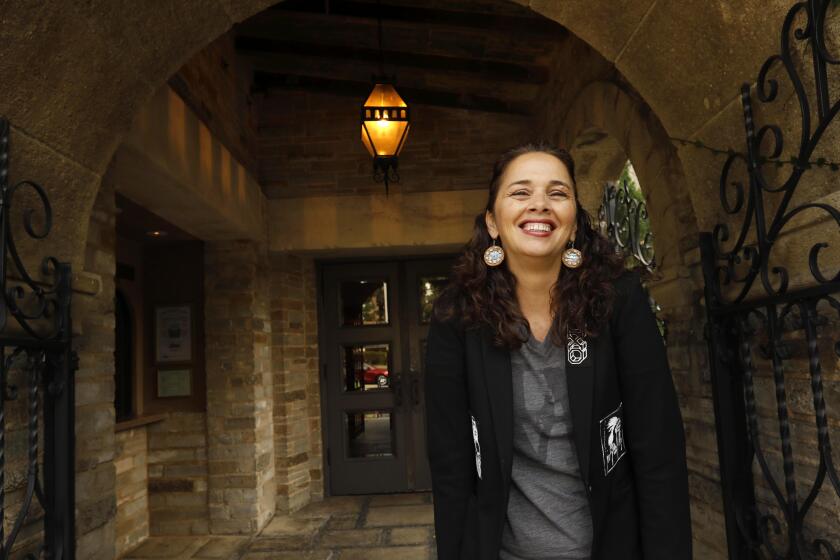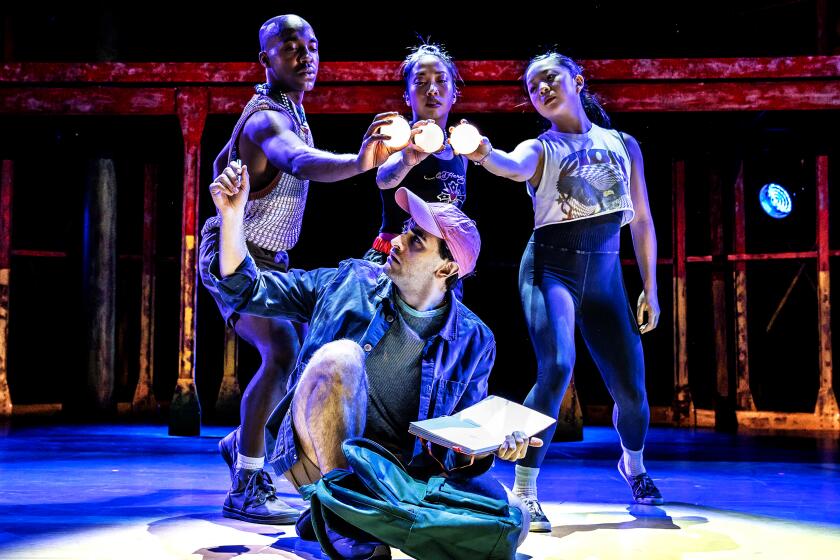L.A.’s so aujourd’hui
EARLY next month, much of the local art world will decamp for Paris for a taste of its history as seen through French eyes. “Los Angeles 1955-1985,” the Pompidou Center’s survey of L.A. art during an invigorating period, will open March 8 with about 350 works by 87 artists, and though the roster is broad, it’s been a hot topic of conversation and contention.
Is it a love letter to Los Angeles artists from Paris? A skewed view of L.A. art from the Eiffel Tower? A French interpretation of the L.A. art scene’s coming of age? Depends on whom you ask.
“It’s high time that something like this is done,” said artist Ed Moses, who has a piece in the show but is angered over the omission of one of his peers. “I think it’s a great thing to do and we are open for it, but everything is ‘Rashomon.’ Everyone has a different view on how to do this.” And every big group show has its critics.
“People who are left out of these shows feel that they are left out of the writing of history and that it’s determined by the luck of the draw,” said artist Alexis Smith, who made the cut in this one.
The controlling view of the Paris exhibition, of course, belongs to the curator, Catherine Grenier, who has constructed a multifaceted chapter of Los Angeles art history. Her chronology begins with works by artists who emerged or flourished artistically in the mid-1950s, including painters Sam Francis and John McLaughlin, Beat luminary Wallace Berman and sculptor Ed Kienholz, known for building gritty environments of found objects. The final galleries will feature artists who rose to prominence in the 1980s, such as Raymond Pettibon, Jim Shaw, Lari Pittman, Jeffrey Vallance, Stephen Prina and Christopher Williams.
Though far from exhaustive -- or even complete -- the 30-year overview filling the top floor of the National Museum of Modern Art at the Pompidou will encompass painting, sculpture, photography, video, performance and film. There will be instantly recognizable works by internationally renowned figures such as Edward Ruscha and David Hockney and sections on mainstream movements: Pop, Minimalism, and Light and Space. The show will also delve into feminist art, African American assemblage and ASCO, a pioneering Chicano performance collective spearheaded by Harry Gamboa, Gronk, Willie Herron and Patssi Valdez.
Greiner began thinking about L.A.’s art history several years ago as she worked on “The Pop Years,” presented at the Pompidou in 2001. “At the time I did a lot of research,” she said by phone from the museum in Paris. “I wanted to confront Pop art in Europe and the United States, and very quickly I realized that I had to confront Pop art on the West Coast as well as New York. It was impossible to include all the material on Los Angeles in that show, but it was very useful in this one.”
Once she decided to devote an entire exhibition to the city, she said, the first problem was to decide which period to cover.
“After speaking with the artists and looking at the art scene, I realized that in France we know the new art scene and the young artists better than the history,” she said. “Young artists from Los Angeles frequently come to Europe and have shows here, but we don’t really know the story of where the art comes from, how it started. What seemed most interesting was to start the exhibition in the mid-’50s, when the Los Angeles art scene really started, and stop in the ‘80s, when Los Angeles become much more international.”
*
Making the cut -- and not
GRENIER had strong support from Alfred Pacquement, director of the museum at the Pompidou, who expressed his interest last fall during a visit to Los Angeles.
“I was shocked at how little California art there was at the inaugural exhibition of the new Museum of Modern Art in New York,” he said to a group of local art aficionados. He saw that, he said, as an opportunity.
Lyn Kienholz, founder and chair of the California/International Arts Foundation in Los Angeles and a close friend of Pacquement, was a liaison for Grenier and took her to many studios. But the curator chose the artists, and figuring out who would represent the 30-year period wasn’t easy.
“First, there are so many artists,” Grenier said. “Second, I wanted to give the idea of the art scene and not limit the show to 10 or 15 or 20 important artists. I wanted to restitute something of the life of the scene. Another problem was that I had to decide which artists I could consider. Most are not really from L.A.; they arrived as students or teachers and stayed. Others were born in Los Angeles, but left early. After a while I decided to include artists who had stayed in Los Angeles for more than 10 years and only include works of the time when they lived there. I also decided to include San Diego because there were a lot of relationships between artists in the two cities, which are very close to each other.”
“I chose to make a large selection of artists,” she said, “but I now see that for each generation I missed some interesting artists. That’s normal in an exhibition; it’s only examples.”
Normal or not, Grenier’s selection of artists has left a small storm in its wake. Moses is miffed that she overlooked painter Charles Garabedian. Other artists, who insisted on anonymity, said they couldn’t understand how the curator could have left out painters Lee Mullican, Emerson Woelffer, Lorser Feitelson, Helen Lundeberg, Carl Benjamin and Karen Carson; sculptor Robert Graham; and ceramicists Peter Voulkos and John Mason.
“I have developed a sense of absurdity about these things,” said artist John Baldessari, whose conceptual work is represented in “Los Angeles.”
Still, Grenier said she is impressed by L.A. artists’ support of each other.
“When you visit an artist like John Baldessari or Mike Kelley, he immediately tells you, you must visit this artist, or perhaps you don’t know this one. That’s really nice.”
And unusual?
“Completely.”
Ambitious as “Los Angeles” is, it has spawned several concurrent exhibitions. The museum will present a show of recent projects by Morphosis, the L.A. architectural firm founded by Thom Mayne, who won the Pritzker Prize in 2005. James Turrell’s “Alta (White),” a 1967 projected-light work recently acquired by the Pompidou, will be temporarily installed at the adjacent Atelier Brancusi, a reconstruction of the Romanian sculptor’s studio. Several commercial galleries in Paris have scheduled shows of works by artists in “Los Angeles,” including Moses, Guy de Cointet and Allen Ruppersberg.
And of course the central exhibition at the Pompidou will have a hefty catalog, in French and English. The 380-page publication will offer an anthology of 400 reviews, interviews and artists’ writings; a think piece on Southern California art by curator Howard Fox of the Los Angeles County Museum of Art; and 600 photographs of artworks, exhibitions and related subjects.
The Pompidou -- a multidisciplinary cultural center and major tourist attraction that includes a library and performance spaces as well as France’s premier showcase for modern and contemporary art -- has a history of thinking big and looking beyond French borders. In its early days, the museum’s curators organized a series of densely packed exhibitions on the relationship of Paris to Berlin, Moscow and New York. But “Los Angeles,” which does not have a Parisian component, is the first show to focus on a single city.
Why this one? “Artists in Europe are really focusing on the Los Angeles art scene,” said Grenier. “For young people, Los Angeles looks more important than New York. It’s the place they want to go and know about. Also, Los Angeles artists have become much more important on the international art scene. They are a real reference for young artists here.”
The Pompidou exhibition is not the first attempt of a European curator to size up L.A.’s art scene. Inevitably, “Los Angeles” will be compared to “Sunshine & Noir: Art in L.A. 1960-1997,” curated by Lars Nittve, then director of the Louisiana Museum of Modern Art in Humlebaek, Denmark, and now director of the Museum of Modern Art in Stockholm. Nittve chose works by 49 artists, 39 of which are in “Los Angeles,” but established a different time frame and explored the dark and light sides of his subject.
“Our exhibition is more historical,” Grenier said, “and it’s chronological. We are showing early works, not student works, but the first works that were really important and influential.... We have a more focused period with more artists. We will show the network of artists and look more broadly at the scene.”
The biggest challenge, she said, was “to make something that makes sense. I think it will work. We really see that it’s a very eclectic scene, but with a strong common spirit among the artists and a link between the generations. There are great expectations for the show here. I think it will be very successful. It will be a vision from Paris. I know that, but I tried to really understand what was happening.”
More to Read
The biggest entertainment stories
Get our big stories about Hollywood, film, television, music, arts, culture and more right in your inbox as soon as they publish.
You may occasionally receive promotional content from the Los Angeles Times.
